
Hieracium , known by the common name hawkweed and classically as hierakion, is a genus of the sunflower (Helianthus) family Asteraceae), and closely related to dandelion (Taraxacum), chicory (Cichorium), prickly lettuce (Lactuca) and sow thistle (Sonchus), which are part of the tribe Cichorieae. Hawkweeds, with their 10,000+ recorded species and subspecies, do their part to make Asteraceae the second largest family of flowers. Some botanists group all these species or subspecies into approximately 800 accepted species, while others prefer to accept several thousand species. Since most hawkweeds reproduce exclusively asexually by means of seeds that are genetically identical to their mother plant, clones or populations that consist of genetically identical plants are formed and some botanists prefer to accept these clones as good species whereas others try to group them into a few hundred more broadly defined species. What is here treated as the single genus Hieracium is now treated by most European experts as two different genera, Hieracium and Pilosella, with species such as Hieracium pilosella, Hieracium floribundum and Hieracium aurantiacum referred to the latter genus. Many members of the genus Pilosella reproduce both by stolons and by seeds, whereas true Hieracium species reproduce only by seeds. In Pilosella, many individual plants are capable of forming both normal sexual and asexual (apomictic) seeds, whereas individual plants of Hieracium only produce one kind of seeds. Another difference is that all species of Pilosella have leaves with smooth (entire) margins whereas most species of Hieracium have distinctly dentate to deeply cut or divided leaves.
A dry roadside dotted with small, ¾ inch red orange flowers, interspersed with very similar yellow ones, and often the white of daisies, is a good sign that you are in Hawkweed country.

Pilosella officinarum, known as mouse-ear hawkweed, is a yellow-flowered species of flowering plant in the daisy family Asteraceae, native to Europe and northern Asia. It produces single, lemon-coloured inflorescences. Like most hawkweed species, it is highly variable and is a member of a species complex of several dozens of subspecies and hundreds of varieties and forms. It is an allelopathic plant.
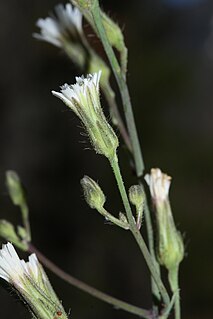
Pilosella albiflora is a common and widespread North American plant in the sunflower family, known by the names white hawkweed and white-flowered hawkweed.

Opus reticulatum is a form of brickwork used in ancient Roman architecture. It consists of diamond-shaped bricks of tuff, referred to as cubilia, placed around a core of opus caementicium.

Vaccinium reticulatum, known as ʻōhelo ʻai in Hawaiian, is a species of flowering plant in the heather family, Ericaceae, that is endemic to Hawaii. It grows at altitudes of 640–3,700 m (2,100–12,140 ft) on lava flows and freshly disturbed volcanic ash on Maui and Hawaiʻi, and less commonly on Kauaʻi, Oʻahu, and Molokaʻi. Adaptations to volcanic activity include the ability to survive ash falls of over 25 cm (9.8 in) depth.

Hieracium umbellatum, the Canadian hawkweed, Canada hawkweed, narrowleaf hawkweed, or northern hawkweed, is a flowering plant in the daisy family Asteraceae.

Deroceras reticulatum, common names the "grey field slug" and "grey garden slug", is a species of small air-breathing land slug, a terrestrial pulmonate gastropod mollusk in the family Agriolimacidae. This species is an important agricultural pest.

Opus incertum was an ancient Roman construction technique, using irregularly shaped and randomly placed uncut stones or fist-sized tuff blocks inserted in a core of opus caementicium.
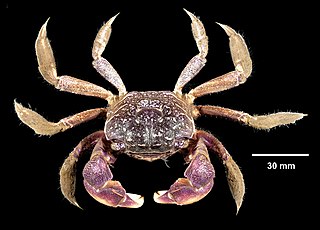
Sesarma reticulatum, the purple marsh crab or simply marsh crab, is a crab species native to the salt marshes of the eastern United States.

Hieracium lachenalii, also known as common hawkweed or yellow hawkweed, is a species of plant in the dandelion tribe within the sunflower family. It is native to Europe but has become established as a weed in Australia and parts of North America. The species was widely known for many years as H. vulgatum, but more recent studies have indicated that the two names represent the same species. The name H. lachenalii was coined in 1802, H. vulgatum in 1819, so the older name is to be used.

Pilosella caespitosa is like several other Pilosella species and has a similar appearance to many of the hawkweeds.
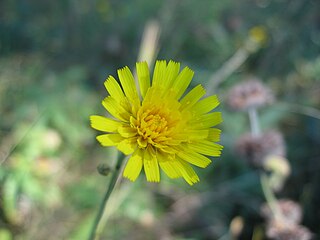
Hieracium sabaudum, also known as New England hawkweed, European hawkweed or a Savoy hawkweed, is a European species of plants in the dandelion tribe within the sunflower family. It is native to Europe but has become naturalized in parts of North America. In Canada, it grows in British Columbia, Québec, and Nova Scotia. In the United States, it has been found in Washington state in the Northwest as well as Wisconsin and the Northeast. The species is considered a noxious weed in Washington state.

Hieracium albertinum, known as western hawkweed or houndstongue hawkweed, is a species of the genus Hieracium that is very similar to Hieracium albiflorum with white flowers but differs in that the flower heads are clustered and the leaves, stems and bracts are covered in a thick layer of hairs. Standing 1 inch (3 cm) to 5 inches (13 cm) tall, it can be found blooming from June through August in forest clearings.
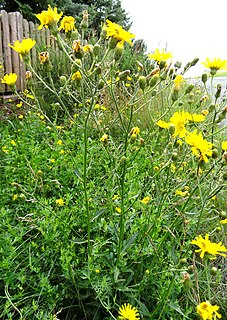
Hieracium laevigatum, or smooth hawkweed, is a Eurasian plant species in the dandelion tribe within the sunflower family. It is widespread across much of Europe and western Asia. It is very similar to Hieracium sabaudum and can be found on dry, more or less nutrient rich soil in light woods, grassy embankments and fields, or on walls.
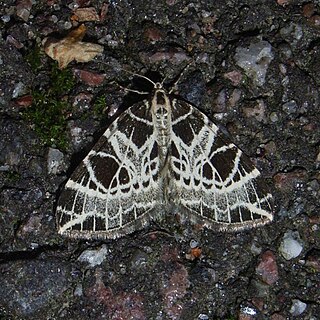
Eustroma reticulatum, the netted carpet, is a moth of the family Geometridae. The species was first described in1775, by the Austrian lepidopterist's, Michael Denis and Ignaz Schiffermüller.

Hellinsia didactylites is a moth of the family Pterophoridae. It is found in most of Europe, east into Russia.
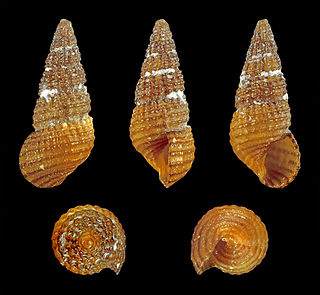
Bittium reticulatum is a species of sea snail, a marine gastropod mollusk in the family Cerithiidae.

Oxyptilus pilosellae is a moth of the family Pterophoridae first described by Philipp Christoph Zeller in 1841. It is found in most of Europe, east to Russia and Asia Minor. It was released as a biological control agent for Hieracium in New Zealand in 1998.

Crombrugghia tristis is a moth of the family Pterophoridae. It is found in most of Europe, except the Benelux, Great Britain, Ireland and Scandinavia. It is also known from southern Siberia, Asia Minor and central Asia. The habitat consists of sandy areas overgrown with Hieracium.

















